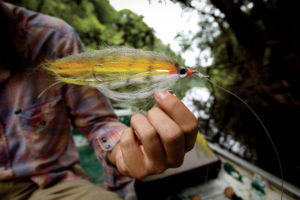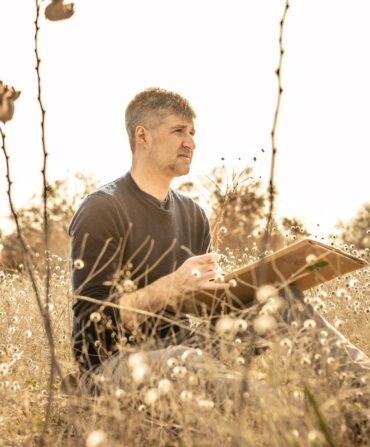Land & Conservation
Fly Fishing in the Land of Giants
Deep in the jungle of South America, a prehistoric fish of massive proportions is at the heart of a new kind of tourism
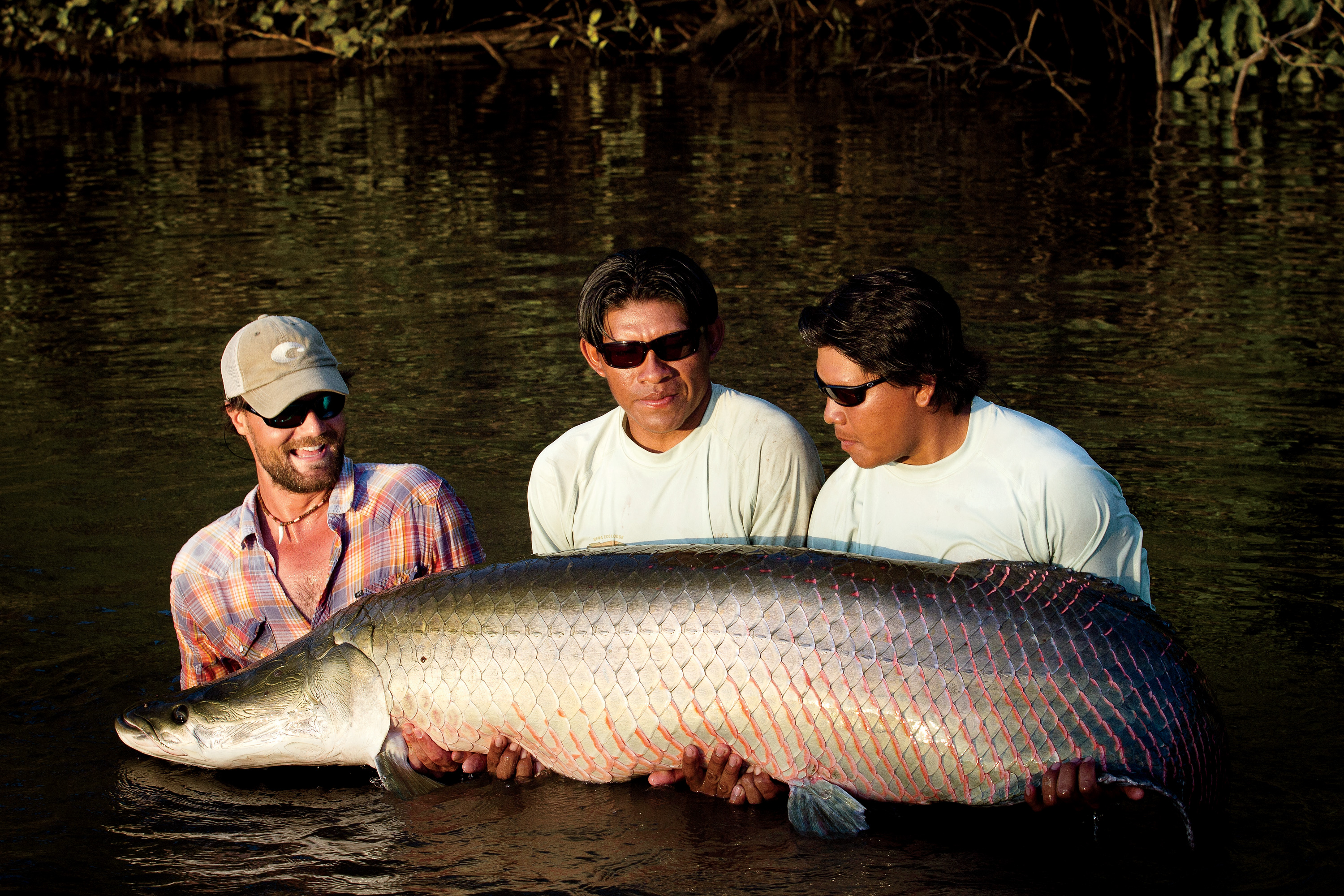
Photo: Rob Howard
Armfuls of Fish
A hefty arapaima is successfully landed in Kumaka Lagoon.
The fifty-year-old rum (golden and nearly as thick as maple syrup) slides smoothly into the mouth of my nine-ounce stainless-steel flask. As it oozes in, I am thinking: A sip or two goes to anyone who catches an arapaima on a fly.
We are headed for extreme southern Guyana—down near that nation’s roadless border with Brazil—to an eco-lodge that ranks among South America’s most remote. Once there, we’ll be fly fishing for arapaima: a quarry that may have lived there since the Age of Dinosaurs. Today’s arapaima run in the realm of seventy to five hundred pounds. And since it was recently discovered that a fly caster could catch them, roughly a dozen have been taken using this technique.
So as the idea of an arapaima hovers in my thoughts, I can only hope someone among us is lucky enough to hook, catch, and release one of these monsters. If so, he deserves a thirty-dollar hit of ron añejo to mark the occasion.
They are truly stange fish: both beautifully streamlined and grotesquely ugly, like early-seventies muscle cars out of Detroit. They have big, aggressively bony skulls combined with odd body colors and tapering back ends.
They’re also, like tarpon, air breathers, meaning they come to the surface to gulp a fresh breath every ten to twenty minutes and then go back beneath the tea-colored water to sulk, giving off a stream of small bubbles as they continue to eat and slowly exhale.

Photo: Rob Howard
An elder from Rewa with handmade bow and arrows.
And they can only be found natively in the wilds of northern South America. To catch one in its natural home, you have to come to the thatch-roofed Rewa Eco-Lodge. It’s not a small journey. To get here, you have to take at least three airplanes—including a small Cessna that lands on a grass strip—and then go down to the Rupununi River landing and take an open boat for about ninety minutes to the lodge. The lodge itself is spartan. Its small plaster huts, with ceiling-hung mosquito nets over the beds, are all set around a central cantina. To get around at night you need a headlamp, if only to look for snakes beneath your feet. The showers are outdoors, in a little walled-off area behind your room. There are candles at night and no screens on the windows. It’s about a ten-minute walk from the little thatch-roofed village of Rewa, and the last civilization for 150 miles all the way to near the Guyana/Brazil border. It may not be the edge of the civilized world (they still have fantastic cooked food and a few cold beers), but it feels pretty damn close.
The fish themselves wait farther afield. They live in isolated oxbow-lake lagoons: placid waters, usually inconveniently deep inside buggy jungles, where the fish breed and eat and grow to gargantuan proportions. Most of the year, the lakes are cut off from nearby rivers and are eventually replenished by annual jungle flooding.
The lagoons are usually crescent shaped. Each is roughly a mile long and averages about four to six feet deep. Other species of fish live in them, too—including ample clouds of piranha—but the arapaima, while they eat almost anything, seem to prefer peacock bass, themselves formidable game fish.
“Most people come down here to fish for peacock bass—and we’re fishing with peacock bass,” says Al Perkinson, one of the organizers of the team.
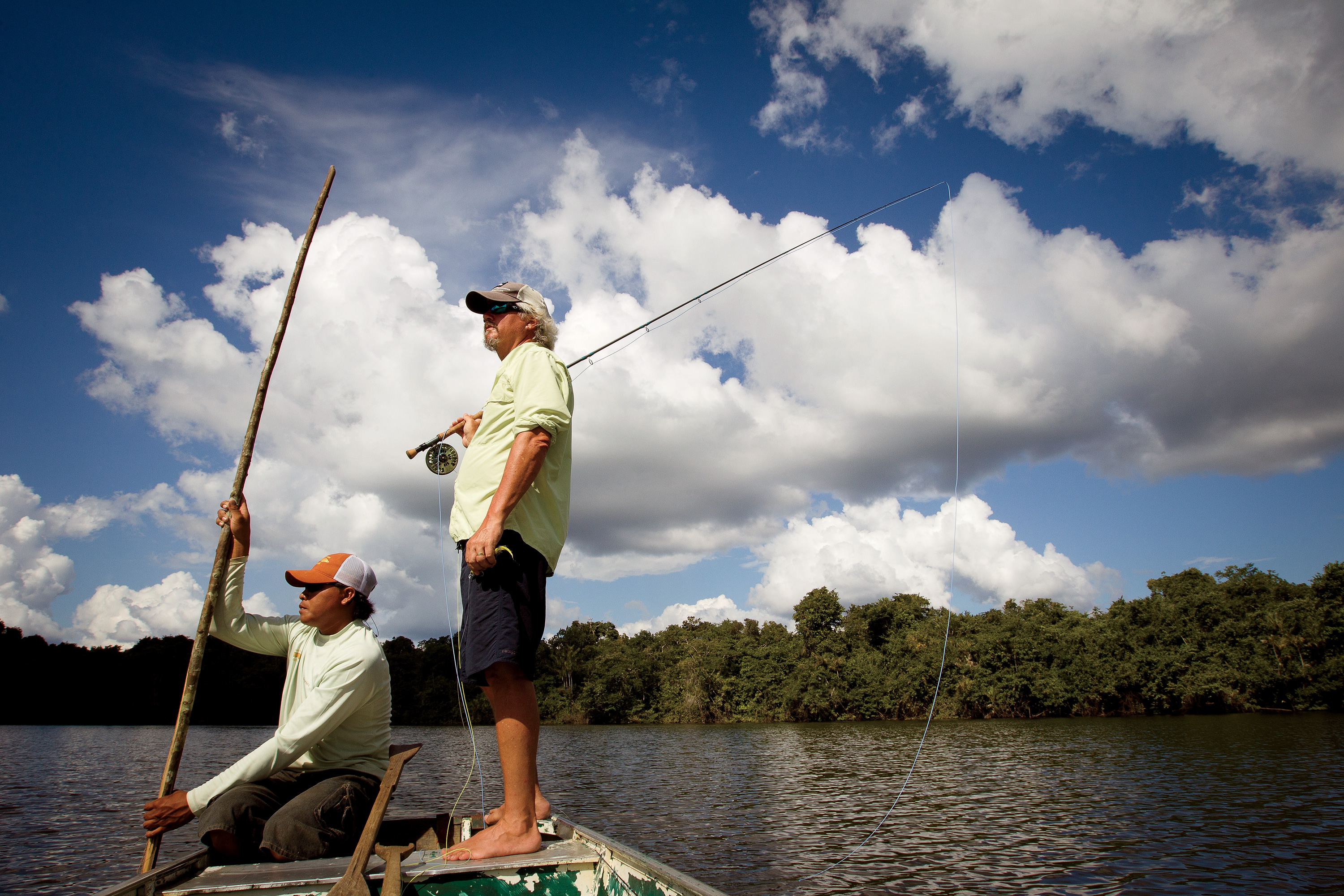
Photo: Rob Howard
Rovin Alvin and Al Perkinson scan for fish in the Kumaka Lagoon.
We’re a clutch of reasonably skilled fly fishermen, put together by Costa sunglasses, brought here to see if this fishery and the associated tourism industry might be a worthy sporting enterprise going forward. Already, Costa has gotten USAID involved as a partner, to promote ecotourism in the region as a way to push sustainable business like sportfishing and bird-watching instead of extracting the area’s natural riches: timber, minerals, and gold. Perkinson first came here on a kind of fluky trip to these parts, something of a “what the hell” flier, and once he’d seen the place, he thought, “Hey, what if we made this a destination?” After that, it was only a question of dedicated bird-watchers and fly fishermen finding out about it through their networks. So far, the plan seems to be working.
But let’s get back to the fishing. To be particular, we’re fishing with flies that imitate peacock bass. They’re six or eight inches long, mostly tied by one of our guides, Oliver White, a professional fishing guide and international resort owner who is quite possibly the father of this technique, having first caught an arapaima on a fly in March 2011.
He’s also an expert flytier. In the water, the peacock-bass-looking flies he creates have streamery feathers and Mylar strands that appear to move and “breathe” like living fish. They’re also the size of ground squirrels, which means they’re hard to cast effectively—or accurately. This is a new frontier of big-game fly fishing. We’re in unknown territory…at its best.
On the first evening, fishing a lagoon called Grassy Pond from an eighteen-foot dugout-wood canoe, we get nothing. Just a few peacock bass nervy enough to bang on a fly a third the size they are.
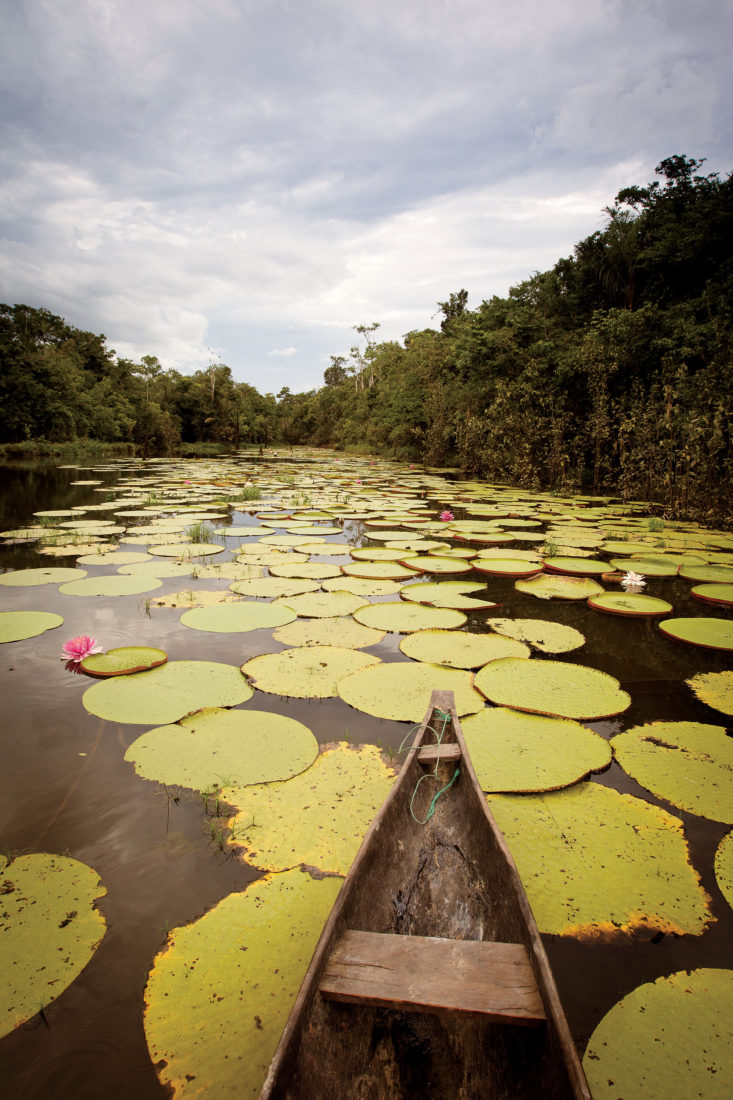
Photo: Rob Howard
Into the Wild
Giant lily pads in one of the many lagoons near the village of Rewa.
The second day, however, things change. We’re in the boat on a lagoon called Simon Pond, watching and waiting as arapaima come up by the dozens to breathe and roll lazily and then submerge back inside their four-foot layer of murky water, where we then cast for them. About 11:00 a.m., one of them (which weighs 250 or 300 pounds and runs seven or eight feet long) swims casually alongside the boat. Oliver White is working as my boat’s guide with a local named Rovin Alvin.
“Dude,” White whispers, tilting his head at the leviathan a few feet off our port side and about half as long as our vessel. The fish has strange undulating fins. As a top-tier predator in this lake, this fish is not afraid. It has probably never seen people. It knows no fear.
There is no alarm. The landscape is silent: an Eden of mirror-flat greenish lagoon and thick green mats of water hyacinths and lily pads and aquatic flowering plants surrounded by deep and rich rain forest under blue equatorial sky. Standing in the bow, I flip my fly ahead of the fish about fifteen feet, then begin to retrieve it in slow, two-inch strips. The fly is attached to a 12-weight rod with 60-pound-test monofilament as a leader tippet—a setup capable of catching fish that can weigh a thousand pounds.
When the fish sucks in the fly, the noise is a vacuum-sounding sha-bump, and it suddenly feels more as if I’ve snagged the bottom than hooked an arapaima. I retain presence of mind to hit the fish—hard: violently stripping in line with my free hand to set the hook and get us tight. The fish, at first, does nothing in response. It doesn’t move. It twists a bit in the water to look at me.
This fish isn’t scared—it’s pissed.
Then it begins to swim off. “Holy crap,” I say out loud to no one in particular. “It’s like I’ve hooked a car…”
When I hit the fish again, to make sure the hook is set, the fish finally decides to hit back. Pop. The line snaps.
Oliver White—our experienced big-game fishing pro—steps to where I’m standing in the boat’s narrow bow. He examines the spot where the hooked fish and the line parted. In the warm morning sun, he smiles and shakes his head.
“That fish just snapped 60-pound-test mono,” he says. “Never thought I’d see that.”
In Guyana, my fishing partner most days is Marty Arostegui. A retired physician from Coral Gables, Florida, Arostegui’s got serious fly-fishing chops—not to mention a hundred-foot fly cast.
“I tell ya,” he says to me one morning in the boat, “this is the most technically demanding fishing I’ve ever seen. It makes fly fishing for big-game tarpon look like kid’s play. You have to do everything perfect to get one of these fish to take. One mistake in technique, and you’re out of luck.”
Arostegui would know. He has hundreds of International Game Fish Association (or IGFA) world records to his name. In fact, he’s down here representing the IGFA (checking the place out), and in so doing he won’t fish with anything heavier than 20-pound tippet, as it wouldn’t be legal under IGFA rules. Just the idea that I’m fishing heavier line than that hurts his feelings a bit, not that he’d ever say so in my direction.
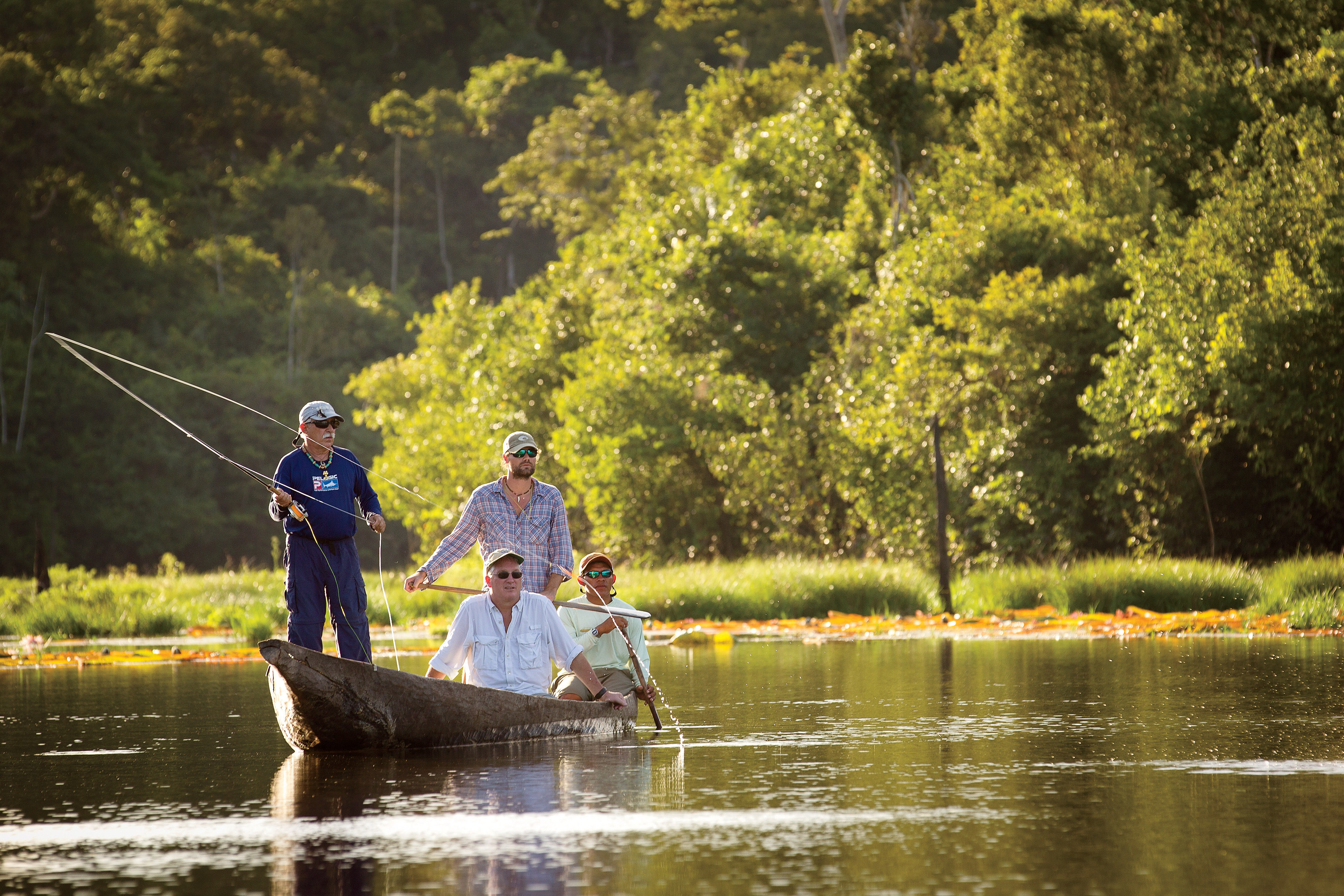
Photo: Rob Howard
Record Breaker
Marty Arostegui casts toward a big arapaima.
On this second day, about twenty minutes after I lose my fish, Arostegui hooks up. It’s a nice one, and he sets the hook just right and hard and the fish—once hooked—steps up to do battle. It leaps a half dozen times. It fights for better than forty minutes, making long runs that let the drag on Arostegui’s Tibor fly reel scream. When the fish leaps, Arostegui does precisely the right thing: gives line and, his rod hand gesturing ahead of him, “bows toward the fish” at his waist to give it more slack.
Finally the fish tires, and Oliver White is able to maneuver the boat close enough to shore to begin the next step in the fight. The fish is tired but not done just yet. White leaves the boat in three feet of water and, warning Arostegui to hang on, reaches out with the wooden paddle we’ve been using to move the boat and taps the fish’s tail with it.
The arapaima streaks off again. Arostegui gets it back close. White has to tap the fish—which runs eighty pounds or more—three more times before it’s tired enough to be controlled and have the hook removed from its mouth.
Then, keeping the line tight, Arostegui enters the water, too. Together—as is the practice with arapaima—Arostegui and White cradle the fish in their arms and unhook it.
After removing the monstrous fly, Arostegui cradles the fish in his arms for twenty or so minutes, working with Alvin to make sure the fish is strong enough to swim off, which it finally does, finning slowly away.
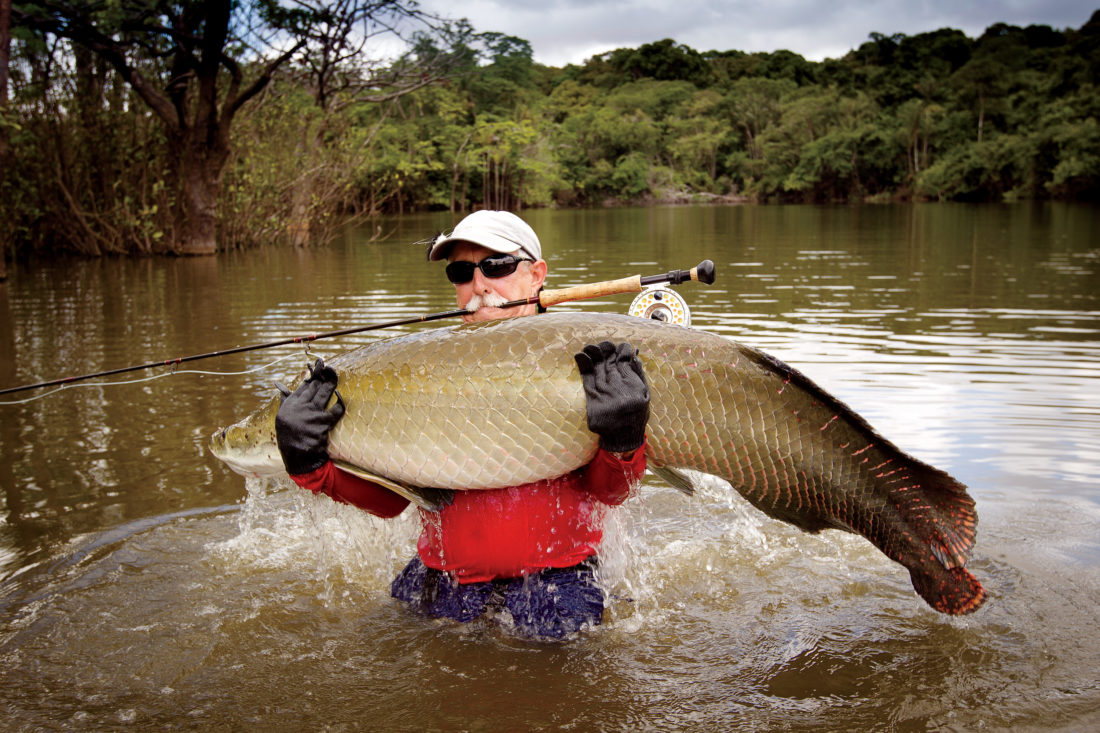
Photo: Rob Howard
Marty Arostegui cradles his prize catch from Simon Pond.
We pull the boat to the edge of the lagoon, beneath a shady tree, and regroup on a small, grassy patch of shore. Arostegui is monumentally pumped. He’s sweating from the exertion; lines of wet beads run down his face. He’s soaked from being chest deep in the water for the last bit, cradling and reviving a fish that weighs roughly as much as most supermodels.
It’s only then that I remember the rum. I step back to the boat and extract the flask from my bag.
Unscrewing the steel cap, I hand it to him. “Well,” I say. “You’re the first one.”
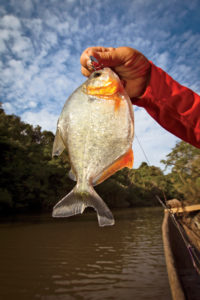
Photo: Rob Howard
A piranha.
Then the drought hits. For several days of hard fishing—up at 4:00 a.m., returning home after dark—we get nothing. We catch peacock bass and arowana and piranha and other toothy denizens from the lagoons, but catching another arapaima on a fly simply doesn’t happen. We all hook several more of them: Arostegui gets three or four more tight lines; Al Perkinson gets four; I achieve a frustrating seven. But no actual fish get so close to us that we have to slip into the water with them and cradle them back to full strength.
Finally, on the last sunset, at a lagoon called Kumaka, as I put down my fly rod and give up the quest in favor of a cold beer, Oliver White decides it’s time to pick up a rod.
Right away, after perhaps fifteen minutes of casting at rolling fish and the trail of bubbles they leave when resubmerging, White hooks an arapaima…which promptly makes a run, leaps, and throws the fly during a dramatic head shake.
White utters some choice words of disappointment.
It’s getting close to twilight now. Night falls fast near the equator; it takes only minutes. White decides to make one last cast, toward a stream of bubbles. And—bam—a fish takes.
What follows next is forty minutes of sweat, as a leaping two-hundred-something-pound fish leaves White bending and reeling: letting the fish run, then slowly horsing it back toward him using the heavy rod and reel. He’s sweating and pulling, bending and lifting the fish. The fish leaps again: five, six, seven times.
Finally, the fish is tired enough that it’s time for that first gentle tap with the paddle, and the whole war begins again. It’s another twenty minutes and a few more touches with the paddle before White and two of the local guides are ready to step from the boat and enter the lagoon. In the muddy brown water, they subdue the arapaima, which lies exhausted and probably weighs in at 240 pounds. The fight now over, White can let the line slack a bit. It takes all three men to lift the arapaima up out of the water—with grins on all the humans’ faces—for memorial photos, before reviving the fish and letting it swim off.

Photo: Rob Howard
Waist Deep in Fish
White and Alvin take a much-needed break after besting a big arapaima.
To celebrate, we all leap into the shallow lagoon to take a cooling swim after a day of hard fishing in the hot tropical sun. On the boat ride home, in the dark, I grab the flask of fifty-year-old rum from my bag, squeakily unscrewing its top, and hand it to White. He takes a long pull. Then another.
He smiles and hands the silver flask back to me—still open. “It’s good,” he says. He smiles. “Go ahead, try some. After all, I can already tell you’ll be back. You’ll get your fish. And then, you can just take one fewer sip the next time.”
I take the flask from White’s hand and can only think to say, “You’re right.”


